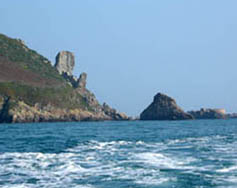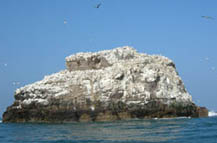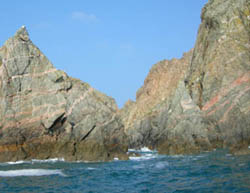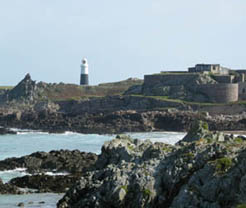Rhapsody in Riduna
Alderney, Channel Islands
by Sarah Shuckburgh
Sarah Shuckburgh discovers why
the tiny Channel island of Alderney is a naturalist’s
paradise.
 Minutes
before I set out for Alderney, my suitcase was stolen from
the locked boot of my car. I had dashed indoors to get a
cloth to clean the windscreen, and in those moments, someone
opened the car door, released the back seat and reached into
the boot. The police came and we scoured the streets of the
urban crime-hotspot where I live, but in vain. Minutes
before I set out for Alderney, my suitcase was stolen from
the locked boot of my car. I had dashed indoors to get a
cloth to clean the windscreen, and in those moments, someone
opened the car door, released the back seat and reached into
the boot. The police came and we scoured the streets of the
urban crime-hotspot where I live, but in vain.
A few hours later, I find myself in another world - safe,
unhurried and friendly. My parents spent their honeymoon in
the Channel Islands sixty years ago, and today my sister and
I have returned with them, to celebrate their diamond
wedding. Alderney – the only Channel Island genuinely in the
Channel - is a perfect place for our nostalgic weekend. This
barren, craggy isle, named Riduna by the Romans, retains a
timeless, unspoilt feel.
 The island measures only 3 miles by one-and-a-half, and its
parliament - with president and ten ‘states’ members – is
more like a parish council. Ridunians have always cherished
their independence – separated from Normandy in 1204, they
are subjects of the English Crown, but are not represented
at Westminster. The island is not part of the United Kingdom
or the European Community. The island measures only 3 miles by one-and-a-half, and its
parliament - with president and ten ‘states’ members – is
more like a parish council. Ridunians have always cherished
their independence – separated from Normandy in 1204, they
are subjects of the English Crown, but are not represented
at Westminster. The island is not part of the United Kingdom
or the European Community.
Alderney’s
only town – St Anne’s – is small and beautiful. We are
staying at La Maison Bourgage, its Georgian façade decorated
in local fashion with mother-of-pearl ormer shells. In the
cobbled high street, I buy a replacement sponge bag,
toiletries and a digital camera (tax-free). Shopkeepers are
shocked to hear about the theft. Alderney has two policemen
but almost no crime. Cars are never locked.
After a delicious lunch of local crab, we visit Alderney’s
first school, founded in 1792 (before any English state
schools), and now an award-winning small museum covering
Alderney’s 2,200million years of geology, its Palaeolithic
inhabitants, Roman ruins, Elizabethan shipwrecks and
Victorian fortresses. When we come to the cases of Nazi
 memorabilia, my parents remember how in June 1940, Churchill
declared Alderney impossible to defend. British troops
withdrew and almost all the islanders were hastily evacuated
to England. Under German occupation, the island was
massively fortified with concrete and barbed wire –
Victorian forts were enlarged, batteries and towers built,
and 37,000 mines laid. Four labour camps held thousands of
Eastern European prisoners; one of them, Sylt, among the
most notorious of SS camps. memorabilia, my parents remember how in June 1940, Churchill
declared Alderney impossible to defend. British troops
withdrew and almost all the islanders were hastily evacuated
to England. Under German occupation, the island was
massively fortified with concrete and barbed wire –
Victorian forts were enlarged, batteries and towers built,
and 37,000 mines laid. Four labour camps held thousands of
Eastern European prisoners; one of them, Sylt, among the
most notorious of SS camps.
 When
shocked islanders returned in 1945, they found their houses
demolished, their livelihoods destroyed. But the Germans had
installed water pipes, electricity and tarmac roads, and
gradually the Ridunians restored their ruined homes and made
a new life among the military relics. Today, the
fortifications make for dramatic coastal vistas. Hitler’s
coastal defences lie half hidden in sand; anti-aircraft
batteries emerge from gorse and heather, and all along the
coast, forts, turrets, towers and pill-boxes perch on rocky
outcrops. When
shocked islanders returned in 1945, they found their houses
demolished, their livelihoods destroyed. But the Germans had
installed water pipes, electricity and tarmac roads, and
gradually the Ridunians restored their ruined homes and made
a new life among the military relics. Today, the
fortifications make for dramatic coastal vistas. Hitler’s
coastal defences lie half hidden in sand; anti-aircraft
batteries emerge from gorse and heather, and all along the
coast, forts, turrets, towers and pill-boxes perch on rocky
outcrops.

After
the war, there were almost no birds in the barren terrain.
But in the last 60 years, Alderney has emerged as a
naturalist’s paradise, with 17 identifiable habitats,
including marine heathland, cliffs and off-shore stacks,
freshwater ponds, wooded valleys and a coastal wetland area
which is recognised as an Area of International Importance
by the Ramsar Convention. The Alderney Wildlife Trust was
established in 2002 to study and promote the tiny island’s
extraordinary biodiversity, which includes 270 species of
birds, 70 species of fish, and more flower species per
square kilometre than anywhere in Britain.
 We
meet Roland Gauvin, dashing head of the Wildlife Trust, and
grandson of distinguished Ridunian physician Sir Henry
Gauvin (whose house in St Anne’s is marked with a plaque).
We follow Roland’s motorbike west, past ancien We
meet Roland Gauvin, dashing head of the Wildlife Trust, and
grandson of distinguished Ridunian physician Sir Henry
Gauvin (whose house in St Anne’s is marked with a plaque).
We follow Roland’s motorbike west, past ancien t open-field
strip-farming, fertilised for centuries with seaweed. At Giffoine Heath, we park by a ruined German battery on a
cliff-top carpeted with gorse and tamarisk. Roland has
brought us
to witness an astonishing spectacle – a noisy colony of
14,000 gannets surrounding a guano-bleached stack. The rocky
outcrop is crammed with birds, preening themselves or
tenderly courting their lifelong mates. Thousands more are
airborne, circling, swooping and dive-bombing into the surf
– the world’s fastest-flying birds. The gannets have
returned every summer since the war. t open-field
strip-farming, fertilised for centuries with seaweed. At Giffoine Heath, we park by a ruined German battery on a
cliff-top carpeted with gorse and tamarisk. Roland has
brought us
to witness an astonishing spectacle – a noisy colony of
14,000 gannets surrounding a guano-bleached stack. The rocky
outcrop is crammed with birds, preening themselves or
tenderly courting their lifelong mates. Thousands more are
airborne, circling, swooping and dive-bombing into the surf
– the world’s fastest-flying birds. The gannets have
returned every summer since the war.
 Just
north of Alderney lies an underwater gorge – the Hurd Deep -
where warm water from the Bay of Biscay mixes with colder
water from the Irish Channel and fresher water from the
Thames, Seine and Rhine. Tides here rise 30 feet, with the
strongest currents in Europe. Uniquely (apart from the Isle
of Man), Alderney owns three miles of seabed beyond its
shores, and Roland predicts that the island could become a
world leader in providing tidal power. Just
north of Alderney lies an underwater gorge – the Hurd Deep -
where warm water from the Bay of Biscay mixes with colder
water from the Irish Channel and fresher water from the
Thames, Seine and Rhine. Tides here rise 30 feet, with the
strongest currents in Europe. Uniquely (apart from the Isle
of Man), Alderney owns three miles of seabed beyond its
shores, and Roland predicts that the island could become a
world leader in providing tidal power.
Stopping every few minutes for passionate descriptions of
Alderney’s wildlife, Roland leads us past the romantic Fort
Clonque to Platte Saline’s steeply shelved shingle. Grosnez
and Albert forts guard the wide arc of Braye beach, where
locals are collecting dark vraic seaweed in baskets. Most of
the mile-long Victorian breakwater is now under water, and
powerful waves threaten the surviving section. We continue
to Saye, once the site of a Nazi labour camp, but today a
peaceful, sandy cove backed by meadows and overlooked by the
19th-century Château l’Etoq.
 From
the lighthouse (no need to lock the car, of course) we
stroll on springy turf past more ruined forts. The Normandy
coast is visible eight miles away, beyond the turbulent
currents of the Race. My father, who crossed to Normandy as
an infantryman in June 1944, talks about Fritz Todt, who
engineered Hitler’s Atlantic defences, and when we reach
Longis Bay, we see an anti-tank wall carving From
the lighthouse (no need to lock the car, of course) we
stroll on springy turf past more ruined forts. The Normandy
coast is visible eight miles away, beyond the turbulent
currents of the Race. My father, who crossed to Normandy as
an infantryman in June 1944, talks about Fritz Todt, who
engineered Hitler’s Atlantic defences, and when we reach
Longis Bay, we see an anti-tank wall carving
 through
the dunes. Here we turn back across Longis common - the
Channel Islands’ earliest nature reserve – undulating
grassland with tangled thickets of gorse, bracken and
bramble. On a hillock above a flooded quarry stands a Nazi
naval lookout and gun battery, a stark art-deco tower known
locally as the Odeon. We look in vain for black rabbits and
blonde hedgehogs, endemic to the island since the 1960s,
their arrival, it’s said, somehow linked with Harrod’s pet
shop. through
the dunes. Here we turn back across Longis common - the
Channel Islands’ earliest nature reserve – undulating
grassland with tangled thickets of gorse, bracken and
bramble. On a hillock above a flooded quarry stands a Nazi
naval lookout and gun battery, a stark art-deco tower known
locally as the Odeon. We look in vain for black rabbits and
blonde hedgehogs, endemic to the island since the 1960s,
their arrival, it’s said, somehow linked with Harrod’s pet
shop.
On
our last day, we take a boat trip round the island. Our
octogenarian parents clamber nimbly down a rusty ladder from
the quay, and we chug through the calm waters of Braye
harbour. As we reach the turbulent Race straits, we are
buffeted by a four-foot swell and Steve, the skipper, has
gleeful tales to tell of shipwrecks, lootings and drownings.
Majestically sombre forts stand on every craggy headland,
silhouetted against shimmering sea and pale , unpolluted sky.
But beyond Longis Bay, the coast becomes wild, rugged and
inaccessible, with hanging valleys slicing through crumbling
pink cliffs. This is a perfect habitat for birds, and my
mother spots cormorants, shags, ravens, fulmars, peregrines,
oyster catchers, herons, little egrets and buzzards. , unpolluted sky.
But beyond Longis Bay, the coast becomes wild, rugged and
inaccessible, with hanging valleys slicing through crumbling
pink cliffs. This is a perfect habitat for birds, and my
mother spots cormorants, shags, ravens, fulmars, peregrines,
oyster catchers, herons, little egrets and buzzards.
At Alderney’s western tip lie the tidal pools, shingle and
sand of the protected wetlands area, home to 100 species of
seaweed. Passing Les Etacs and the tiny island of Ortac, we
see puffins, guillemots and razorbills, and marvel again at
the grandeur of the gannets, their six-foot wings glistening
white with black tips. Here, the treacherous Swinge pounds
against scattered reefs - dangerous for ships, but welcoming
for grey Atlantic seals.
 Even
Alderney’s airport has a comforting, homely feel. It dates
from 1935 – the first in the Islands. As we wait for our
plane, my mother, sister and I knit blanket-squares with
needles and wool from a box in the waiting room. The airport
staff are still talking about my stolen suitcase, but I have
forgotten all about it. Over the six decades of my parents’
marriage, the island has recovered from desolation, and
developed a rich and magical blend of manmade and natural
landscape. What is one stolen suitcase compared with that? Even
Alderney’s airport has a comforting, homely feel. It dates
from 1935 – the first in the Islands. As we wait for our
plane, my mother, sister and I knit blanket-squares with
needles and wool from a box in the waiting room. The airport
staff are still talking about my stolen suitcase, but I have
forgotten all about it. Over the six decades of my parents’
marriage, the island has recovered from desolation, and
developed a rich and magical blend of manmade and natural
landscape. What is one stolen suitcase compared with that?
First published by the Telegraph
©SarahShuckburgh |